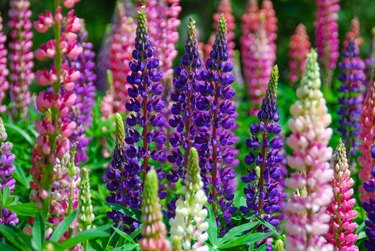
Take a slender, upright stem, cover it with glue, and stick it deep into a box of brightly colored flower petals. That's a close approximation of the look of a lupine flower, one of the most popular garden perennials. Of the hundreds of species in the Lupinus genus, you can find easy-care North American natives or hybrids in many different blossom colors. These bright, attractive flowering plants don't need regular pruning, but deadheading will encourage the plants to bloom again.
Meet the Lupine
Video of the Day
Would your garden look more enticing with spires of flowers in brilliant shades of royal blue, deep purple, or lipstick pink? Lupine (Lupinus spp.) might be just the plant you need. Whether you select the original wild species (Lupinus perennis) with its sapphire flowers, Texas bluebonnet (Lupinus texensis) with blue and white blossoms, or Russell hybrid lupines (Lupinus polyphyllus) with blue, pink, yellow, or white flowers, they will fill your backyard with color from late spring through summer.
Video of the Day
The individual lupine blossom is shaped like a pea flower, and there are many of them densely packed on each erect spike. The flowers are situated on the top of stalks that can be 2 feet or taller. Lupine leaves are grayish green and can be covered with silver down. The flowers produce pea-pod-like legumes with up to 12 seeds inside. You might expect these uplifting plants to be hard to care for, but they really aren't.
Care for Your Lupine Flowers
Lupine is a native wildflower which means that it won't make many demands on the gardener. Everybody who grows lupines does so for their blooms, so full sun is the only good option. They will survive in partial sun but the less sun, the fewer blossoms.
Lupine are said to thrive in U.S. Department of Agriculture plant hardiness zones 4a through 8a. If you live in a cold climate and are growing these as annuals, the soil isn't very important; lupine will grow in almost any type. But as perennials, they send down long tap roots to access water and nutrients, so a site in sandy or loose loam is better. Water every week or so during the growing season.
Deadhead Your Lupines
Deadheading is a gardening term that might startle novices but is familiar to seasoned gardeners. Deadheading means removing the blossoms of a plant when they begin to wilt. This accomplishes a variety of good things. It prevents seeds from forming, thus eliminating self-seeding. It also encourages the plant to bloom again since it doesn't need to pour its energy into producing seeds.
With lupine, deadheading is the only pruning the plants usually need. Since the flowers are composite spikes of many small flowers, you might think you should wait until every individual flower is wilting, but that's not a great idea. Experts recommend pruning when the flowers at the bottom of the spike are wilting, even if the top part of the spike looks good. To deadhead lupine, just prune off the flower spike by cutting the entire stem below the flower and above the next set of leaves.